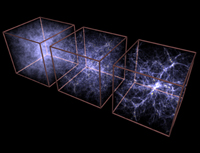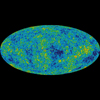Disclaimer: This material is being kept online for historical purposes. Though accurate at the time of publication, it is no longer being updated. The page may contain broken links or outdated information, and parts may not function in current web browsers. Visit chandra.si.edu for current information.
Arrested Development of the Universe
by P.EdmondsDecember 16, 2008 ::
The nature of dark energy, the mysterious agent causing the expansion of the Universe to accelerate, is one of the biggest problems in science. To understand it better, astronomers are finding new ways to probe its effects on the Universe. The recent breakthrough by Alexey Vikhlinin and colleagues studies how dark energy slows down the evolution of large structures, resulting in arrested development of the Universe.
What exactly is different about today's Universe because of the presence of dark energy? Perhaps the most dramatic demonstration can be given by answering the following question: what would the Universe look like now if there had been no dark energy? That is, if the repulsive effects of dark energy had been switched off in the early Universe, but everything else - like the amount of matter and the tiny irregularities seen in the cosmic microwave background - was identical to our Universe. In this alternative scenario, what would things look like after 13.7 billion years?(*) In the contest between the pull of dark matter and the push of dark energy, what would have happened if dark energy forfeited before the game really got going?
It turns out that the effects are quite dramatic. The Universe would be expanding 50% slower if there had not been dark energy. Cosmic structures like galaxies and galaxy clusters would be much more massive and still growing. Galaxy merging would be widespread. Our own Milky Way would probably have already merged with Andromeda, and the combined galaxy would be well on its way towards a first entrance into the Virgo cluster. It is remarkable to think that this mysterious agent, which has had such a large impact on the Universe, has only been known for about 10 years.
The dark energy effects are qualitatively illustrated on a figure (at right) showing how the scale of the Universe (bottom) and the growth of large structures (top) in it are thought to change with time. The change in scale of the Universe is what supernova work and other distance techniques have measured. The growth of structure is represented by the weight of galaxy clusters, from both the formation of new objects and the overall increase in mass of existing clusters.
The effects we discussed above follow from comparison of the evolution of the observed Universe (shown in orange) with the evolution of the hypothetical Universe that was mentioned earlier, where dark energy was switched off long ago (shown in yellow). We abbreviate the latter by calling it the "high density" Universe, since the lack of dark energy and acceleration results in the evolution of a denser Universe. Note that the scale of the observed Universe increases as acceleration occurs, making growth of clusters more difficult than in the high density model. So, the increase in weight of galaxy clusters slows down with time (equivalently, fewer massive clusters form). This is how dark energy stifles the growth of structures and delays development.
Another important question is the following: can we rule out the possibility that the *observed* Universe is free of dark energy? This question is closer to the spirit of the Vikhlinin et al. study. To investigate it, one can invent a hypothetical Universe that has the same properties as the Universe now, but has no dark energy and therefore never accelerated (see the blue line in the accompanying graphic). Can the behavior of this "low density" Universe be distinguished from the observed Universe? In effect, can one look backwards in time at distant clusters and detect the effects of dark energy?
The answer from the Vikhlinin et al. study is a conclusive "yes". The observed accelerating universe was expanding slower in the past than a universe with the same low density today but without dark energy. [Think of this driving analogy: if you are just passing a slow car and you know you are going faster, this means that you were behind that car a few seconds ago.] Slower expansion means more growth in the past in an accelerating universe with dark energy, and that is exactly what is seen. The gain in weight of a typical galaxy cluster over the last 5 billion years is about 30% bigger than that in a low density Universe without dark energy. Put another way, there is a factor of 12.5 increase in the number of massive clusters, but in a low density model there would only be a factor of 7 increase.
Based on previous work with clusters, astronomers already knew that we live in a low density Universe today, in terms of the matter content alone, rather than a high density one. Since 1998 we have known, from measurements of distances to galaxies with supernovae, that dark energy currently dominates the mass-energy content of the Universe. The new work now exposes effects of dark energy on growth of cosmic structures, and in combination with earlier studies provides the most complete picture of what dark energy is.
------------------------------
(*) 13.7 billion years is the age of the Universe based on WMAP observations of the cosmic microwave background
Disclaimer: This material is being kept online for historical purposes. Though accurate at the time of publication, it is no longer being updated. The page may contain broken links or outdated information, and parts may not function in current web browsers. Visit chandra.si.edu for current information.







